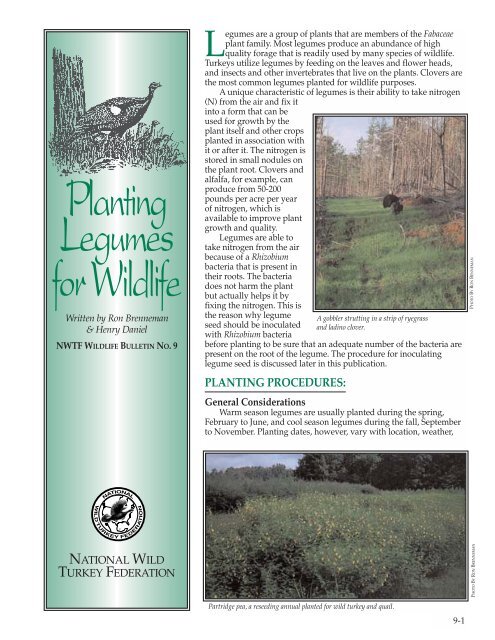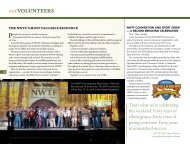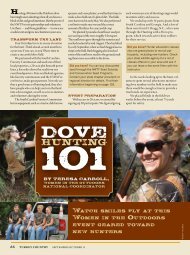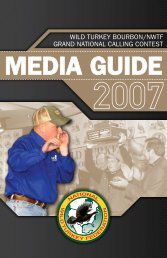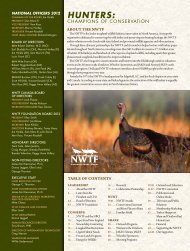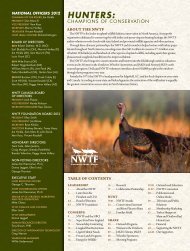Planting Legumes - National Wild Turkey Federation
Planting Legumes - National Wild Turkey Federation
Planting Legumes - National Wild Turkey Federation
You also want an ePaper? Increase the reach of your titles
YUMPU automatically turns print PDFs into web optimized ePapers that Google loves.
<strong>Planting</strong><br />
<strong>Legumes</strong><br />
for <strong>Wild</strong>life<br />
Written by Ron Brenneman<br />
& Henry Daniel<br />
NWTF WILDLIFE BULLETIN NO. 9<br />
NATIONAL WILD<br />
TURKEY FEDERATION<br />
<strong>Legumes</strong> are a group of plants that are members of the Fabaceae<br />
plant family. Most legumes produce an abundance of high<br />
quality forage that is readily used by many species of wildlife.<br />
<strong>Turkey</strong>s utilize legumes by feeding on the leaves and flower heads,<br />
and insects and other invertebrates that live on the plants. Clovers are<br />
the most common legumes planted for wildlife purposes.<br />
A unique characteristic of legumes is their ability to take nitrogen<br />
(N) from the air and fix it<br />
into a form that can be<br />
used for growth by the<br />
plant itself and other crops<br />
planted in association with<br />
it or after it. The nitrogen is<br />
stored in small nodules on<br />
the plant root. Clovers and<br />
alfalfa, for example, can<br />
produce from 50-200<br />
pounds per acre per year<br />
of nitrogen, which is<br />
available to improve plant<br />
growth and quality.<br />
<strong>Legumes</strong> are able to<br />
take nitrogen from the air<br />
because of a Rhizobium<br />
bacteria that is present in<br />
their roots. The bacteria<br />
does not harm the plant<br />
but actually helps it by<br />
fixing the nitrogen. This is<br />
the reason why legume<br />
seed should be inoculated<br />
with Rhizobium bacteria<br />
before planting to be sure that an adequate number of the bacteria are<br />
present on the root of the legume. The procedure for inoculating<br />
legume seed is discussed later in this publication.<br />
PLANTING PROCEDURES:<br />
A gobbler strutting in a strip of ryegrass<br />
and ladino clover.<br />
General Considerations<br />
Warm season legumes are usually planted during the spring,<br />
February to June, and cool season legumes during the fall, September<br />
to November. <strong>Planting</strong> dates, however, vary with location, weather,<br />
Partridge pea, a reseeding annual planted for wild turkey and quail.<br />
9-1<br />
PHOTO BY RON BENNEMAN<br />
PHOTO BY RON BRENNEMAN
9-2<br />
FIGURE 1 - Legume <strong>Planting</strong> Dates and Peak Forage Production*/Southern Areas<br />
JAN FEB MAR APR MAY JUN JUL AUG SEP OCT NOV DEC<br />
ALYCECLOVER<br />
ALFALFA<br />
ALSIKE CLOVER<br />
ARROWLEAF CLOVER<br />
AUSTRIAN WINTERPEA<br />
BALL CLOVER<br />
BERSEEM CLOVER<br />
BIRDSFOOT TREFOIL<br />
BUTTON CLOVER<br />
COWPEAS<br />
CRIMSON CLOVER<br />
HAIRY VETCH<br />
LADINO WHITE CLOVER<br />
(OSCEOLA, REGAL, TRIPOLI)<br />
LATCHO FLATPEA<br />
PARTRIDGE PEA<br />
RED CLOVER<br />
SUBTERRANEAN CLOVER<br />
VELVETBEAN<br />
WHITE DUTCH CLOVER<br />
<strong>Planting</strong> date Production<br />
* <strong>Planting</strong> dates and peak production periods vary somewhat with location, weather, and other factors. This figure provides general information only.<br />
FIGURE 2 - Legume <strong>Planting</strong> Dates and Peak Forage Production*/Northern Areas<br />
JAN FEB MAR APR MAY JUN JUL AUG SEP OCT NOV DEC<br />
ALYCECLOVER<br />
ALFALFA<br />
ALSIKE CLOVER<br />
BIRDSFOOT TREFOIL<br />
COWPEAS<br />
CRIMSON CLOVER<br />
HAIRY VETCH<br />
LADINO WHITE CLOVER<br />
(OSCEOLA, REGAL, TRIPOLI)<br />
LATCHO FLATPEA<br />
RED CLOVER<br />
SUBTERRANEAN CLOVER<br />
WHITE DUTCH CLOVER<br />
<strong>Planting</strong> date Production<br />
* <strong>Planting</strong> dates and peak production periods vary somewhat with location, weather, and other factors. This figure provides general information only.
Birdsfoot trefoil and dutch white clover do well planted together in cooler areas.<br />
elevation, and other factors. In<br />
some of the cooler areas legumes<br />
can be planted with success<br />
throughout much of the summer<br />
months. In this publication we<br />
have made two broad<br />
classifications, southern areas and<br />
northern areas, for planting dates<br />
and peak forage production,<br />
Figures 1 and 2. Even within these<br />
classifications there is much<br />
variation.<br />
In northern areas peak forage<br />
production occurs during the<br />
spring and summer months.<br />
Forage is available, however,<br />
throughout much of the fall and<br />
into the early winter until snow<br />
cover makes in unavailable. Even<br />
in these areas, with short growing<br />
seasons and cool temperatures,<br />
legumes can be available to<br />
wildlife for eight months or more.<br />
The timing of legume forage<br />
availability in the warmer,<br />
southern areas is different than<br />
the northern areas, but the length<br />
of time it is available is similar.<br />
FIGURE 3 - GUIDE TO COMMONLY PLANTED LEGUMES<br />
During the hottest part of the<br />
summer many of the legumes are<br />
dormant with peak production<br />
occurring in the spring and fall.<br />
Some types of legumes are<br />
annual and others are perennial.<br />
Annual legumes generally<br />
produce forage for one year and<br />
then must be replanted again.<br />
Particularly in warmer areas,<br />
however, many of the annuals will<br />
reseed and produce an adequate<br />
stand in succeeding years. For<br />
example, we know of a crimson<br />
COOL SEASON WARM SEASON<br />
ANNUAL PERENNIAL ANNUAL<br />
SOILS SOILS SOILS<br />
WET WELL WET WELL WELL<br />
DRAINED DRAINED DRAINED<br />
BALL CLOVER ARROWLEAF CLOVER ALSIKE CLOVER RED CLOVER ALYCECLOVER<br />
BERSEEM CLOVER BUTTON CLOVER REGAL LADINO CLOVER BIRDSFOOT TREFOIL COWPEAS<br />
CRIMSON CLOVER OSCEOLA LADINO CLOVER ALFALFA VELVETBEAN<br />
SUBTERRANEAN CLOVER WHITE DUTCH CLOVER TRIPOLI CLOVER<br />
HAIRY VETCH TRIPOLI CLOVER<br />
COWPEAS<br />
9-3<br />
PHOTO BY RON BRENNEMAN
Preparation of the seedbed is an important step in a successful legume planting.<br />
ALFALFA<br />
ARROWLEAF CLOVER<br />
AUSTRIAN WINTERPEA<br />
BALL CLOVER<br />
BERSEEM CLOVER<br />
BIRDSFOOT TREFOIL<br />
BUTTON CLOVER<br />
COWPEAS<br />
CRIMSON CLOVER<br />
HAIRY VETCH<br />
LADINO WHITE CLOVER<br />
RED CLOVER<br />
SUBTERRANEAN CLOVER<br />
9-4<br />
FIGURE 4 - OPTIMUM SOIL pH FOR BEST LEGUME GROWTH<br />
clover stand in Georgia that is still<br />
producing excellent forage six<br />
years after the initial planting.<br />
Perennial legumes will persist<br />
for more than on year and often<br />
for a much longer period of time.<br />
We have seen a clover and alfalfa<br />
mixture persist for more than<br />
seven years in northern<br />
Pennsylvania, with only<br />
occasional topdressing with lime<br />
and fertilizer.<br />
Soil Preparation<br />
When preparing seedbeds<br />
two things should be considered,<br />
the size of the seed to be planted<br />
and moisture conditions.<br />
Seedbeds for small seeded<br />
varieties, such as clovers, need to<br />
be as smooth and lump free as<br />
possible when planted at about<br />
1/8 inch depth. Larger seed<br />
varieties like peas do not require<br />
as much precaution because they<br />
have the vigor to push through<br />
adverse soil conditions.<br />
Preparing a seed bed when<br />
the soil is too wet will create a<br />
hard crust and a rough seed bed.<br />
Certain conditions will require<br />
tilling when the soil is wet, such<br />
as when a heavy weed growth is<br />
present and the only way to<br />
4.0 5.0 6.0 7.0 8.0<br />
pH<br />
PHOTO BY RON BRENNEMAN
harrow it under is after a good<br />
rain. In these situations another<br />
harrowing a few days later will<br />
be required to smooth the soil<br />
out and planting can be done at<br />
that time.<br />
When minimal soil moisture<br />
is present, preparing a seed bed<br />
will release the moisture needed<br />
to germinate the seed. If this is<br />
the case, the smaller seed<br />
varieties should be planted very<br />
shallow. The larger seed varieties<br />
can still be planted, but deeper to<br />
reach the existing moisture.<br />
If the seedbed is too loose it<br />
will not hold moisture and there<br />
will not be good seed-soil<br />
contact. Before planting the seed<br />
compact the soil. You cannot<br />
overly compact a seedbed. Even<br />
running a 4-wheeler over the<br />
seedbed before planting will<br />
help.<br />
Fertilizing and Liming<br />
<strong>Legumes</strong> require fertilizer<br />
and lime for proper growth. For<br />
best results have your soil tested<br />
to determine the amount of<br />
fertilizer and lime needed. The<br />
cost of the fertilizer and lime will<br />
exceed that of the legume seed<br />
so you do not want to use any<br />
more than necessary for good<br />
growth.<br />
It is not necessary to add<br />
nitrogen when planting legumes.<br />
If you cannot get the soil tested a<br />
general recommendation for<br />
fertilizer would be 250 pounds<br />
per acre of 5-10-15. Commercial<br />
fertilizer without any nitrogen is<br />
not readily available. Most forest<br />
soils, where many wildlife<br />
openings are planted, are acidic<br />
so lime is needed to increase the<br />
soil pH. In Figure 4 the optimum<br />
pH for some of the common<br />
Applying lime and fertilizer is one of the major costs of establishing a stand of legumes.<br />
FIGURE 5 - LEGUME<br />
PLANTING GUIDE<br />
SHADY AREAS<br />
LADINO WHITE CLOVER<br />
LATCHO FLATPEA<br />
SUBTERRANEAN CLOVER<br />
WHITE DUTCH CLOVER<br />
BEST IN ACID SOILS<br />
ALYCECLOVER<br />
ARROWLEAF CLOVER<br />
BALL CLOVER<br />
BIRDSFOOT TREFOIL<br />
COWPEAS<br />
CRIMSON CLOVER<br />
HAIRY VETCH<br />
LADINO WHITE CLOVER<br />
SUBTERRANEAN CLOVER<br />
VELVETBEANS<br />
TOLERATES WET SOILS<br />
ALSIKE CLOVER<br />
BALL CLOVER<br />
BERSEEM CLOVER<br />
LADINO WHITE CLOVER<br />
RED CLOVER<br />
WHITE DUTCH CLOVER<br />
BEST IN LOW<br />
FERTILITY AREAS<br />
COWPEAS<br />
VELVETBEANS<br />
GOOD COLD TOLERANCE<br />
ALFALFA<br />
AUSTRIAN WINTERPEA<br />
BIRDSFOOT TREFOIL<br />
LATCHO FLATPEA<br />
RED CLOVER<br />
REGAL LADINO CLOVER<br />
WHITE DUTCH CLOVER<br />
PHOTO BY GENE SMITH<br />
9-5
Austrian winterpea, a good soil builder and wildlife food.<br />
9-6<br />
PHOTO BY RON BRENNEMAN<br />
A right-of-way planted with clover<br />
makes an excellent wildllife opening.<br />
PHOTO BY RON BRENNEMAN
legumes is listed. Generally a pH<br />
of 6.0 or higher is best for<br />
legumes. Again, a soil test is<br />
highly recommended, but if one is<br />
not taken apply 1-2 tons per acre<br />
of lime.<br />
Fertilizer and lime can be<br />
applied either before or after the<br />
seed bed has been prepared.<br />
Ideally it should be applied prior<br />
to seed bed preparation and<br />
harrowed into the soil. If time,<br />
weather conditions, or late arrival<br />
of soil test results prevent this,<br />
lime and fertilizer can be applied<br />
after the seed bed has been<br />
prepared and planted.<br />
Seed Inoculation<br />
All legume seed should be<br />
mixed with the proper inoculant<br />
before it is planted. It is<br />
particularly important if the seed<br />
is being planted in an area where<br />
legumes have not been grown<br />
before.<br />
Inoculant is very inexpensive.<br />
When buying it check the date on<br />
the package to make sure it is<br />
fresh. Also use the proper<br />
inoculant for the type of legume<br />
you are planting. Alfalfa,<br />
partridge pea and ladino clover,<br />
for example, each require a<br />
different type of inoculant.<br />
If you do not use the inoculant<br />
immediately after buying it store<br />
it in a dry, relatively cool place out<br />
of the direct sunlight. Just prior to<br />
planting the seed inoculate it as<br />
follows:<br />
• Place the seed in a container.<br />
• In another container mix the<br />
required amount of water with<br />
the inoculant to form a slurry.<br />
• Add a commercially<br />
available sticker or sticking agent<br />
to this slurry and mix it well.<br />
• Add the slurry to the seed<br />
and mix well.<br />
• If you get the seed too wet<br />
add a little lime to absorb the<br />
water.<br />
• If possible let the seed dry<br />
for about an hour before planting.<br />
Plant the seed as soon as<br />
possible after it has been<br />
inoculated. If it is not planted the<br />
day it is inoculated, reinoculate<br />
before planting.<br />
Amixture of orchardgrass and subterranean clover.<br />
Do not mix inoculated seed<br />
with fertilizer as the salts from the<br />
fertilizer can kill the bacteria in<br />
the inoculant.<br />
<strong>Planting</strong> the Seed<br />
Buy high quality legume seed.<br />
Make sure the bag has a complete<br />
analysis tag attached from a<br />
certified seed laboratory. The test<br />
date should be within the last 12<br />
months. Legume seed can be<br />
planted by broadcasting or<br />
drilling. Most individuals who are<br />
planting for wildlife do not have<br />
drills, therefore, broadcasting is<br />
most common.<br />
Because seeding rates for<br />
many legumes are relatively low<br />
and the seed is small, (Figure 6)<br />
care must be used when<br />
broadcasting the seed. It is easy to<br />
spread an acres worth of seed<br />
over a relatively small area.<br />
Two ways of broadcasting<br />
legume seed are by using a bucket<br />
and your hand or mixing the seed<br />
with dry sand and using a handheld<br />
spreader. Avoid dumping the<br />
seed alone in a hand held<br />
spreader. A few cranks of the<br />
handle and your seed will be<br />
gone.<br />
FIGURE 6 - LEGUME<br />
SEEDING RATES<br />
ALYCECLOVER<br />
BROADCAST<br />
LBS. PER ACRE<br />
15-20<br />
ALFALFA 15-18<br />
ALSIKE CLOVER 4-6<br />
ARROWLEAF CLOVER 5-10<br />
AUSTRIAN WINTERPEA 30-40<br />
BALL CLOVER 2-3<br />
BERSEEM CLOVER 20<br />
BIRDSFOOT TREFOIL 6-12<br />
BUTTON CLOVER 10<br />
COWPEAS 60<br />
CRIMSON CLOVER 20-30<br />
HAIRY VETCH 20-25<br />
LATCHO FLATPEA 20-30<br />
LADINO WHITE CLOVER 6-8<br />
PARTRIDGE PEA 15-20<br />
RED CLOVER 12-15<br />
SUBTERRANEAN CLOVER 15<br />
VELVETBEAN 25-30<br />
WHITE DUTCH CLOVER 4<br />
9-7<br />
PHOTO BY RON BRENNEMAN
9-8<br />
Covering the Seed<br />
Legume seed should be covered<br />
lightly with soil after it has been<br />
broadcast. Covering it with too<br />
much soil can reduce germination<br />
and lead to a poor stand. Most<br />
legume seed should be covered to a<br />
depth of only 1/8 inch. Use extreme<br />
care when covering seed with a<br />
harrow, disk or drag to not cover too<br />
deep. Running over the seedbed<br />
with a 4-wheeler after planting will<br />
firm the seedbed and put the seed in<br />
good contact with the soil.<br />
Legume/Grass Mixtures<br />
Several species of legumes<br />
planted together or with grasses<br />
make a good mixture for wild<br />
turkeys and other wildlife. Some<br />
legume/grass mixtures can provide<br />
nearly a year-round source of food<br />
in the south. Most of these mixtures<br />
would be productive for many years<br />
with a minimum of annual<br />
maintenance.<br />
Legume/grass mixtures can be<br />
established by planting the seed at<br />
the same time or no-till seeding the<br />
legumes into an existing stand of<br />
grass. Species of grass that are<br />
commonly planted in association<br />
with legumes include Kentucky<br />
bluegrass, orchardgrass, bahiagrass,<br />
bermudagrass, timothy and fescue.<br />
Thanks to Donald M. Ball,<br />
Auburn University and Gerald A.<br />
Wunz, retired, Pennsylvania Game<br />
Commisssion, for reviewing the<br />
manuscript and providing helpful<br />
input.<br />
Ordering legumes through the<br />
NWTF is easy. Simply click here to<br />
download a Project HELP catalog. In<br />
it, you will find a number of<br />
legumes available directly from the<br />
NWTF.


